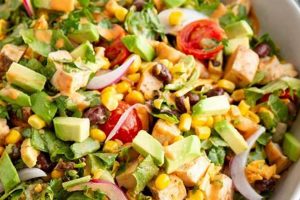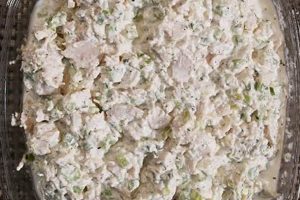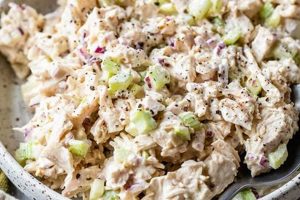A simple preparation involving cooked chicken, typically from a can, combined with mayonnaise and often celery, onion, and seasonings, constitutes a readily available and adaptable meal option. Variations can include the addition of grapes, apples, nuts, or dried cranberries. It’s commonly served chilled on bread, crackers, or lettuce cups.
This dish offers a convenient, affordable, and protein-rich meal solution. Its adaptability lends itself to diverse palates and dietary restrictions, accommodating ingredient substitutions or omissions. Historically, canned chicken emerged as a pantry staple, contributing to the dish’s popularity as a quick and easy meal, especially during times when fresh poultry was less accessible. This convenience and versatility maintain its relevance in contemporary cuisine.
The following sections will explore variations on this classic recipe, offering tips for ingredient selection, preparation techniques, and creative serving suggestions. Discussions on nutritional information and storage guidelines will also be provided.
Tips for Preparing Canned Chicken Salad
Optimizing canned chicken salad involves attention to ingredient selection and preparation techniques. The following tips offer guidance for creating a flavorful and satisfying dish.
Tip 1: Drain the chicken thoroughly. Excess liquid can dilute the salad’s flavor and create a watery consistency. Pressing the chicken gently with a paper towel removes additional moisture.
Tip 2: Choose high-quality mayonnaise. Mayonnaise forms the base of the salad, significantly impacting its overall taste. Opting for a flavorful mayonnaise enhances the final product.
Tip 3: Add fresh ingredients for enhanced flavor and texture. Incorporating finely diced celery and onion provides a crisp, refreshing counterpoint to the richness of the mayonnaise and chicken.
Tip 4: Season thoughtfully. Simple seasonings like salt, pepper, and paprika elevate the chicken’s flavor. Experimenting with herbs like dill or chives adds complexity.
Tip 5: Consider incorporating textural elements. Chopped nuts, such as pecans or walnuts, or dried cranberries add a welcome crunch and burst of flavor.
Tip 6: Chill thoroughly before serving. Chilling allows the flavors to meld and creates a more refreshing salad. A minimum of 30 minutes in the refrigerator is recommended.
Tip 7: Adjust ingredients to taste. Recipes offer guidance, but individual preferences vary. Adjust seasonings, mayonnaise quantity, and add-ins to achieve desired flavor profiles.
By following these tips, one can elevate canned chicken salad from a simple convenience food to a truly enjoyable culinary experience. Proper draining, quality ingredients, and thoughtful seasoning contribute significantly to a superior final product.
The following section offers various serving suggestions and creative adaptations for incorporating this versatile dish into different meals.
1. Canned Chicken
Canned chicken plays a pivotal role in the basic chicken salad recipe, serving as the primary protein source and influencing the dish’s overall character. Understanding its attributes provides a foundation for appreciating its function within this culinary context.
- Convenience and Shelf Life
Canned chicken offers significant advantages in terms of convenience and extended shelf life. Ready to eat directly from the can, it requires no cooking, simplifying meal preparation. Its extended shelf stability ensures availability even without immediate access to fresh poultry. This characteristic contributes significantly to the ease and speed with which a basic chicken salad can be assembled.
- Texture and Moisture Content
The texture of canned chicken, typically shredded or chunky, lends itself well to incorporation into salads. Its inherent moisture content contributes to the overall consistency of the final dish, although excess liquid should be drained to prevent a watery salad. The pre-cooked nature of canned chicken ensures a tender and consistent texture throughout the salad.
- Nutritional Profile
Canned chicken provides a good source of protein, essential for satiety and muscle maintenance. It also contains varying amounts of sodium, depending on the brand and packing liquid. Draining and rinsing the chicken can reduce sodium content. Nutritional information available on product labels allows informed choices regarding dietary needs.
- Flavor Considerations
While canned chicken offers a neutral flavor profile, allowing it to absorb the flavors of other ingredients in the salad, some brands may include added seasonings. This inherent neutrality makes it a versatile base, readily accepting the flavors of mayonnaise, seasonings, and other add-ins. This adaptability contributes to the wide range of flavor profiles achievable in chicken salad.
The attributes of canned chicken convenience, texture, nutritional content, and neutral flavor directly influence the preparation and outcome of the basic chicken salad recipe. Its ease of use makes the recipe accessible, while its adaptability allows for a diverse range of flavor combinations, solidifying its place as a key ingredient in this classic dish.
2. Mayonnaise
Mayonnaise serves as a crucial component in basic chicken salad prepared with canned chicken. Its role extends beyond simply binding ingredients; it contributes significantly to the salad’s texture, flavor, and overall palatability. An understanding of mayonnaise’s properties and its impact on the final dish is essential for crafting a successful chicken salad.
- Emulsification and Texture
Mayonnaise is an emulsion of oil and egg yolks, stabilized by an emulsifier, often lecithin found in the yolks. This emulsion creates a creamy, viscous texture that coats the chicken and other ingredients, binding them together and providing a smooth mouthfeel. The consistency of the mayonnaise directly influences the final texture of the salad, ranging from a light and fluffy mixture to a denser, richer product.
- Flavor Enhancement and Balance
Mayonnaise contributes a tangy, slightly acidic flavor derived from vinegar or lemon juice used in its preparation. This tanginess complements the savory notes of the chicken and provides a counterpoint to other ingredients. The richness of the oil in mayonnaise also contributes to the overall flavor profile, enhancing the perception of the other ingredients and creating a balanced, harmonious taste.
- Moisture and Cohesion
The inherent moisture content of mayonnaise contributes to the salad’s overall moisture level, preventing dryness. This moisture also aids in distributing flavors throughout the mixture and helps maintain the salad’s cohesive structure, preventing it from crumbling or separating. Careful consideration of the mayonnaise-to-chicken ratio ensures the desired consistency and prevents an excessively wet or dry salad.
- Variations and Adaptations
Different types of mayonnaise, such as those flavored with herbs, spices, or other additions like roasted garlic or chipotle peppers, can significantly alter the final flavor profile of the chicken salad. Substituting plain yogurt or Greek yogurt for a portion of the mayonnaise can create a lighter, tangier salad with a lower fat content. These adaptations allow for customization based on dietary preferences and desired flavor outcomes.
The interplay between mayonnaise and the other ingredients in a canned chicken salad is fundamental to the dish’s success. Its emulsifying properties, flavor contributions, and influence on moisture content contribute significantly to the final product’s texture, taste, and overall appeal. Selecting the appropriate type of mayonnaise and carefully considering its proportion within the recipe are crucial steps in achieving a balanced and flavorful chicken salad.
3. Seasoning
Seasoning plays a critical role in elevating canned chicken salad from bland to flavorful. While the inherent taste of canned chicken and mayonnaise provides a foundation, the judicious use of seasonings enhances the overall sensory experience, adding depth and complexity. The following facets explore the impact of seasoning on this simple yet versatile dish.
- Balancing Flavors
Seasoning balances the richness of mayonnaise and the neutral flavor of canned chicken. Salt, a fundamental seasoning, enhances the inherent flavors of the ingredients. Black pepper adds a subtle bite, while a touch of acidity, such as lemon juice or vinegar, brightens the overall flavor profile, preventing the salad from becoming overly rich. The interplay of these basic seasonings establishes a balanced flavor foundation.
- Enhancing Complexity
Beyond basic seasonings, incorporating herbs and spices adds depth and complexity to canned chicken salad. Dried or fresh herbs, such as dill, chives, or parsley, introduce aromatic notes. Spices like paprika, onion powder, or garlic powder contribute savory warmth. The careful selection and combination of herbs and spices can transform a simple chicken salad into a more nuanced and flavorful dish.
- Customization and Personalization
Seasoning allows for customization based on individual preferences. Curry powder can create an Indian-inspired chicken salad, while smoked paprika imparts a smoky depth. Experimenting with different combinations of herbs, spices, and other flavor enhancers like hot sauce or Worcestershire sauce allows for a wide range of flavor profiles, catering to diverse palates. This adaptability makes canned chicken salad a versatile canvas for culinary creativity.
- Freshness and Aromatics
Freshly ground spices and freshly chopped herbs offer more pronounced aromas and flavors compared to their dried counterparts. The vibrant flavors of fresh herbs brighten the salad, while freshly ground spices release more intense aromatic compounds. This emphasis on freshness elevates the overall sensory experience of the dish, contributing to a more vibrant and appealing final product.
The considered use of seasoning is essential for maximizing the flavor potential of canned chicken salad. From balancing basic flavors to introducing complex notes and allowing for personalized adaptations, seasoning transforms a simple combination of ingredients into a truly satisfying culinary experience. Attention to seasoning elevates the dish beyond mere sustenance, creating a flavorful and enjoyable meal.
4. Texture
Texture plays a significant role in the overall enjoyment of canned chicken salad. The interplay of varying textures creates a more engaging sensory experience, elevating the dish beyond a simple combination of ingredients. Understanding the contribution of different textural elements provides insights into crafting a more satisfying and palatable chicken salad.
- The Role of Canned Chicken
The texture of canned chicken, often shredded or chunky, provides a base level of texture. While generally soft, the variations in shred size or chunkiness offer some textural variation. Draining excess liquid prevents a mushy consistency, allowing the chicken to maintain its integrity within the salad and contribute to a more pleasing mouthfeel.
- Balancing Soft and Crisp Elements
Incorporating crisp elements provides a counterpoint to the softness of the chicken and mayonnaise. Finely diced celery and onion offer a refreshing crunch, creating textural contrast. The interplay of soft and crisp textures enhances the eating experience, preventing a monotonous mouthfeel. Other crisp additions, such as water chestnuts or chopped apples, further diversify the textural profile.
- Adding Textural Interest with Nuts and Seeds
Nuts and seeds introduce another layer of textural complexity. Chopped walnuts, pecans, or sunflower seeds provide a satisfying crunch and contribute to a more substantial and enjoyable eating experience. The addition of these elements also introduces a subtle nutty flavor that complements the other ingredients, further enhancing the overall sensory experience.
- The Influence of Mayonnaise
Mayonnaise, while primarily a binding agent, also influences the texture of the salad. The quantity of mayonnaise used affects the overall creaminess and consistency. A higher mayonnaise-to-chicken ratio results in a smoother, creamier salad, while a lower ratio yields a chunkier, more textured salad. Balancing these proportions achieves the desired textural outcome.
The interplay of textures in canned chicken salad significantly impacts its appeal. Balancing the softness of the chicken and mayonnaise with the crispness of vegetables and the crunch of nuts or seeds creates a dynamic and satisfying culinary experience. Careful consideration of these textural elements elevates the dish from a simple combination of ingredients to a more complex and enjoyable meal.
5. Freshness
Freshness plays a crucial role in the overall quality and enjoyment of a basic chicken salad recipe using canned chicken. While canned chicken offers convenience and extended shelf life, incorporating fresh ingredients and adhering to proper food safety practices significantly impacts the final product’s flavor, texture, and safety.
- Ingredient Selection
Selecting fresh produce enhances the flavor and textural complexity of the salad. Crisp celery, vibrant onions, and juicy grapes or apples contribute a refreshing counterpoint to the richness of the mayonnaise and the neutral flavor of the canned chicken. Wilted or spoiled produce detracts from the overall quality and introduces potential food safety risks. Sourcing high-quality, fresh ingredients elevates the final dish.
- Mayonnaise Quality
While commercially produced mayonnaise has a relatively long shelf life, using fresh, high-quality mayonnaise enhances the overall flavor and texture of the salad. Checking expiration dates and ensuring proper storage prevent spoilage and maintain optimal quality. The freshness of the mayonnaise contributes significantly to the overall freshness perception of the finished product.
- Preparation Timing
Preparing the chicken salad as close to serving time as possible maximizes freshness. Pre-chopping ingredients and storing them separately until assembly helps maintain their individual freshness and prevents premature wilting or softening. Prompt refrigeration after preparation further preserves the salad’s quality and minimizes the risk of bacterial growth.
- Food Safety Practices
Adhering to proper food safety practices is paramount in ensuring the safety and enjoyment of the chicken salad. Thorough handwashing, using clean utensils and cutting boards, and refrigerating the salad promptly after preparation minimize the risk of contamination and foodborne illness. Maintaining a clean and organized food preparation area further contributes to food safety.
Prioritizing freshness in every aspect of preparing a basic chicken salad with canned chicken, from ingredient selection to safe handling practices, ensures a flavorful, enjoyable, and safe culinary experience. While the convenience of canned chicken contributes to the recipe’s ease of preparation, the incorporation of fresh components elevates the final product, resulting in a more satisfying and palatable dish.
6. Simplicity
Simplicity defines the very essence of a basic chicken salad recipe using canned chicken. This characteristic stems from several factors, contributing to its enduring appeal as a convenient and adaptable meal option. The reliance on readily available pantry staples, minimal preparation steps, and straightforward ingredient combinations underscores this inherent simplicity. A can of chicken, mayonnaise, and a few basic seasonings form the core of the recipe, requiring minimal culinary expertise or time investment. This ease of preparation makes it an accessible option for individuals with limited cooking skills or time constraints. For example, a quick lunch can be assembled in minutes by combining canned chicken with mayonnaise, salt, and pepper, highlighting the recipe’s inherent practicality.
The simplicity of this recipe extends beyond its basic form, allowing for adaptable customization without sacrificing ease of preparation. The addition of readily available ingredients like chopped celery, onion, grapes, or nuts introduces flavor and textural complexity without demanding complex culinary techniques. This adaptability makes the recipe suitable for diverse palates and dietary preferences, further reinforcing its practicality. For instance, substituting plain yogurt for a portion of the mayonnaise creates a lighter version, while adding curry powder transforms the flavor profile. These modifications maintain the recipe’s fundamental simplicity while expanding its versatility.
In conclusion, simplicity serves as a defining feature of the basic chicken salad recipe with canned chicken. This simplicity, born from readily available ingredients and minimal preparation steps, contributes significantly to its enduring popularity as a convenient and adaptable meal. The inherent ease of customization further broadens its appeal, allowing individuals to tailor the recipe to their specific preferences without sacrificing its fundamental simplicity. This understanding underscores the recipe’s value as an accessible and versatile culinary solution for a variety of situations.
Frequently Asked Questions
This section addresses common inquiries regarding the preparation and consumption of basic chicken salad made with canned chicken.
Question 1: How can excess moisture in canned chicken salad be prevented?
Thorough draining of the canned chicken is crucial. Pressing the chicken gently with a paper towel further reduces moisture content, preventing a watery salad.
Question 2: What type of mayonnaise is recommended?
Standard mayonnaise works well, but higher-quality mayonnaise or variations like olive oil mayonnaise enhance the flavor profile. Experimentation with different mayonnaises allows for personalized flavor adjustments.
Question 3: How long can canned chicken salad be stored safely?
Properly stored in an airtight container in the refrigerator, canned chicken salad typically remains safe for consumption for three to five days. Monitoring for changes in odor or appearance is crucial, and discarding the salad if any spoilage is suspected is recommended.
Question 4: Can alternative ingredients be substituted for celery and onion?
Yes, ingredients such as chopped water chestnuts, bell peppers, or grapes offer textural and flavor variations. These substitutions cater to individual preferences and dietary restrictions, allowing recipe customization.
Question 5: How can the sodium content in canned chicken salad be reduced?
Opting for low-sodium canned chicken and rinsing the chicken under cold water before use effectively reduces sodium content. Careful selection of other ingredients and minimizing added salt during preparation also contributes to sodium reduction. Using low-sodium or no-salt-added mayonnaise provides additional control over sodium intake.
Question 6: Can frozen chicken be used instead of canned chicken?
While frozen chicken can be used, it requires thawing and cooking before incorporation into the salad. Canned chicken offers greater convenience. If using frozen chicken, ensure it is fully cooked and cooled before combining with other ingredients to maintain food safety and desired texture.
Addressing these common inquiries provides a comprehensive understanding of preparing and consuming basic chicken salad made with canned chicken, enabling informed choices regarding ingredients, storage, and potential modifications.
The following section offers a selection of recipe variations to expand upon the basic formula, providing inspiration for creative culinary exploration.
Conclusion
This exploration of the basic chicken salad recipe with canned chicken has highlighted its simplicity, versatility, and enduring appeal. From the core components of canned chicken and mayonnaise to the nuances of seasoning and textural elements, each aspect contributes to the final product’s overall character. The adaptability of this recipe allows for customization based on individual preferences and dietary needs, solidifying its place as a convenient and adaptable meal solution. The importance of freshness and food safety practices in maximizing quality and minimizing risks has also been underscored.
The basic chicken salad recipe with canned chicken stands as a testament to the enduring power of simple, accessible cuisine. Its adaptability and ease of preparation ensure its continued relevance in kitchens worldwide, offering a canvas for culinary creativity and a reliable source of nourishment. Continued exploration of flavor combinations and ingredient adaptations promises further evolution of this classic dish.






